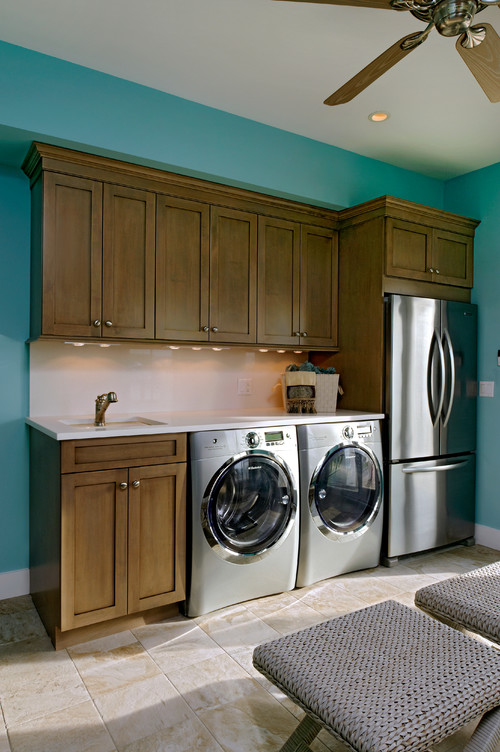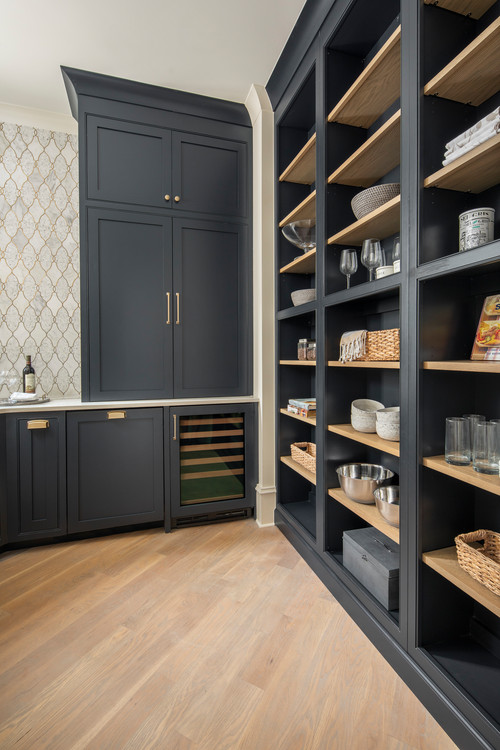
tulcarion/Getty Images
Open-plan kitchens may reign supreme in home design, but one of the oft-cited downsides is that your cooking—and its attendant mess—are on full display for all to see.
If you’re tired of exposing your dirty dishes and carrot peels to guests perched on your living room couch, there is a solution: a kitchen scullery—a smaller, secondary kitchen used for storing bulk pantry goods, entertaining essentials (platters, glassware, table linens), and little-used appliances and gadgets.
Kitchen sculleries might sound archaic, but designers say they’re making a comeback. Their appeal stems not only from their ability to hide food prep chaos, but also, in this age of the novel coronavirus, to serve as a buffer against germs entering your main living area.
Here’s more about kitchen sculleries, including their backstory and what to consider if you’re thinking of installing one in your home.
What is a scullery? A brief history—and modern-day benefits
Photo by Hermitage Kitchen Design Gallery
In Victorian times, the maids and cooks for rich families would toil in the scullery, a dark room at the back of house where they would wash dishes, store cookware, and do laundry. Today’s scullery serves many of the same storage and cleaning functions, and includes prepping areas for large meals and dinner parties.
“In open-plan kitchens, there’s no hiding this kind of mess and it’s especially useful if you hold a lot of catered events,” says Melanie Turner, an architect at Perkins & Will.
Sara Chiarilli, an interior designer with Artful Conceptions, likes the scullery option for sizable homes with more than three people and for homeowners who really enjoy cooking.
“A scullery also offers a space that isn’t wide open—so it can be an option for extra cabinetry and privacy that’s been lost in modern kitchens that are so on display,” she adds.
And when the kitchen is such a big part of your living space, a scullery can contain ho-hum items (blender, juicer, rice cooker), leaving your main counters free to show off a beautiful fruit bowl or vase of flowers.
Photo by DEANE Inc | Distinctive Design & Cabinetry
How a kitchen scullery can protect against the coronavirus
The coronavirus pandemic has further underscored a scullery’s utility since, after venturing out for groceries, the return home can sometimes feel fraught as homeowners rush to wash their hands and remove masks and gloves. A well-positioned scullery, off the garage or as part of the mudroom, can handle these tasks, as it creates a buffer between the outer world and your home’s interior.
“Having a scullery in the COVID-19 era is especially smart because you can unload groceries in it, wipe them down, and not drag them through your house to the main kitchen,” explains Kobi Karp, principal at the eponymous architecture and interior design firm.
Plus, with fewer trips being made to the grocery store, the need to house extra food for longer periods of time is more apparent. A scullery solves this problem as a second fridge and stand-alone freezer can be installed here.
A scullery can also be used for accepting deliveries (packages, takeout food, wine).
Main features of a scullery
Photo by DEANE Inc | Distinctive Design & Cabinetry
As a separate kitchen space, a scullery can hold everything that doesn’t fit in your main cooking area.
“Smaller sculleries may have a bar sink, wine fridge, and a small amount of storage, while larger ones can function as a second kitchen with another dishwasher, full-size sink, toaster oven, and lots of storage,” notes Chiarilli.
Counter space is also a must here for preparing food and storing appliances.
“Enough surface area also serves as a landing space for the groceries before you begin unpacking,” says Karp.
Shelves that span the entire wall and go up to the ceiling will make the most of your space, and built-in cupboards can hold crockery, pots and pans, and serving pieces, he adds.
“You can also store countertop appliances in a scullery that don’t get a lot of use or unsightly ones like the microwave—and you could combine this space with your laundry room and double up on common functions with the counter space, storage, and extra sink,” says Turner.
The biggest drawback to a scullery is that it takes up space, notes Karp, so smaller homes wouldn’t be candidates. And some of Turner’s clients prefer to have the cooking and cleaning chores handled in one spot, rather than shuttling back and forth between a kitchen and a scullery—and then having to tidy both areas.
“And there’s a social aspect to cooking and even cleaning, so you’d miss out on having people gather around these activities if you have a scullery,” she adds.
The post Does Your Open-Plan Kitchen Need a Scullery These Days? appeared first on Real Estate News & Insights | realtor.com®.






No comments:
Post a Comment